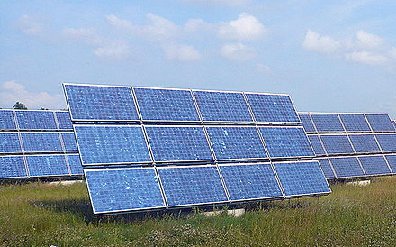This page is one of three introducing insolation-concepts. An overview is at insolation. The other two pages are: insolation definitions and types of radiation.
The solar radiation that fills our sky can be direct, diffuse or reflected radiation.
On this page, we first explain the difference between the two main components of the light in the sky: direct radiation and diffuse radiation.
Second, we talk about what conditions increase the percentage of diffuse radiation in the sky and also about which places tend to have the most direct radiation and which places the least.

Third, we explain why tilted solar collectors actually gather a little less diffuse radiation than untilted ones.
Finally, after covering reflected radiation and how much snow can impact it, we conclude with global radiation.
"Direct radiation" is also sometimes called "beam radiation" or "direct beam radiation". It is used to describe solar radiation traveling on a straight line from the sun down to the surface of the earth.
"Diffuse radiation", on the other hand, describes the sunlight that has been scattered by molecules and particles in the atmosphere but that has still made it down to the surface of the earth.
Direct radiation has a definite direction but diffuse radiation is just going any which way. Because when the radiation is direct, the rays are all travelling in the same direction, an object can block them all at once. This is why shadows are only produced when direct radiation is blocked.
When the sky is clear and the sun is very high in the sky, direct radiation is around 85% of the total insolation striking the ground and diffuse radiation is about 15%. As the sun goes lower in the sky, the percent of diffuse radiation keeps going up until it reaches 40% when the sun is 10° above the horizon.1

Atmospheric conditions like clouds and pollution also increase the percentage of diffuse radiation. On an extremely overcast day, pretty much 100% of the solar radiation is diffuse radiation. Generally speaking, the larger the percentage of diffuse radiation, the less the total insolation.
The percentage of the sky's radiation that is diffuse is much greater in higher latitude, cloudier places than in lower latitude, sunnier places.
Also, the precentage of the total radiation that is diffuse radiation tends to be higher in the winter than the summer in these higher latitude, cloudier places. The sunniest places, by contrast, tend to have less seasonal variation in the ratio between diffuse and direct radiation.
As an example, compare London, UK (51° North; wet and mild climate) to Aden, Yemen (19.5° North; dry and hot climate).
In London's sunniest month (June), the average daily irradiation is about 5.5 kWh/m2 and about 50% of that is diffuse. In December, the irradiation is less than 1 kWh/m2 and by far the majority of that radiation is diffuse.
In Aden's sunniest month (May), the average daily irradiation is about 7 kWh/m2 and less than 30% of the radiation is diffuse. In December, the irradiation is around 5.25 kWh/m2 and about 35% is diffuse radiation.2
As discussed in sun angle and insolation, when you tilt your solar panels so that the sun's rays are hitting them at a 90° angle, you are maximizing the amount of direct radiation that they receive.

However, since diffuse radiation is generally pretty equally distributed throughout the sky, the most diffuse radiation is gathered when your solar panels are laying down horizontally.
The steeper your solar panels are tilted, the less of the sky they are facing and the more of the sky's diffuse radiation they miss out on. If, for example, your solar collectors are tilted at a 45° angle, they are facing away from about a quarter of the sky and would only collect about three-fourths of the diffuse radiation in the sky.(Source:3)
Still, because direct radiation is much more intense than diffuse radiation, the amount of radiation missed by tilted solar panels is generally more than compensated for by the extra radiation gained by tracking the sun.
Photovoltaic and solar hot water systems can make use of both direct radiation and diffuse radiation. Concentrated solar power, on the other hand, requires a lot of direct radiation to do much of anything at all.
Reflected radiation describes sunlight that has been reflected off of non-atmospheric things such as the ground. Asphalt reflects about 4% of the light that strikes it and a lawn about 25%. However, solar panels tend to be tilted away from where the reflected light is going and reflected radiation rarely accounts for a significant part of the sunlight striking their surface.
An exception is in very snowy conditions which can sometimes raise the percentage of reflected radiation quite high. Fresh snow reflects 80 to 90% of the radiation striking it. In Fairbanks, Alaska, USA (64.5° North) there is still snow on the ground in April and May and the reflected radiation portion of the total radiation can be 25%.4

"Global insolation" is the total insolation: direct + diffuse + reflected light. Often people use it to refer to the total insolation on a horizontal surface and if they want to talk about the total radiation striking a surface with some specific tilt, they will say something like "total insolation on an XYZ° tilt", etc.
"Normal radiation" describes the radiation that strikes a surface that is at a 90° angle to the sun's rays. As discussed in sun angle and insolation, by constantly keeping our solar collectors at a 90° angle with the sun, we maximize the direct radiation received on that day.
Therefore, "normal global radiation" generally tells us what the absolutely most sun we could get is (as discussed earlier in this page, if all the radiation in the sky is diffuse, you do best to just lay your solar collectors down flat - although in that case yuo aren't going to be gathering much solar radiation anyway).
If this page has been a help to you
please recommend it with Google+ below:
1. p. 66, Encyclopaedia of Geomorphology; Author: Mahammad Naqi; Publisher: Anmol Publications Pvt Ltd; Publication date: 2006).
2. The data in this section was reconstructed from tables on p. 77 of Photovoltaic power for Europe: an assessment study; Authors: Michael R. Starr, Wolfgang Palz, Commission of the European Communities; Publication date: 1983;
3. p. 416 Renewable and efficient electric power systems; Author: Gilbert M. Masters; Publisher: John Wiley & Sons; Publication date: 2004.
4. This information was reconstructed from a graph of a report done by the Cold Climate Housing and Research Center in Fairbanks Alaska. The graph is here: Performance of PV arrays.
The "not-interrupting-content-as-promised", side links below are not paid ads. They are personal recommendations from David Watson, who is wise and thoughtful:

Visit B Willard's
Lonesome Design Shop